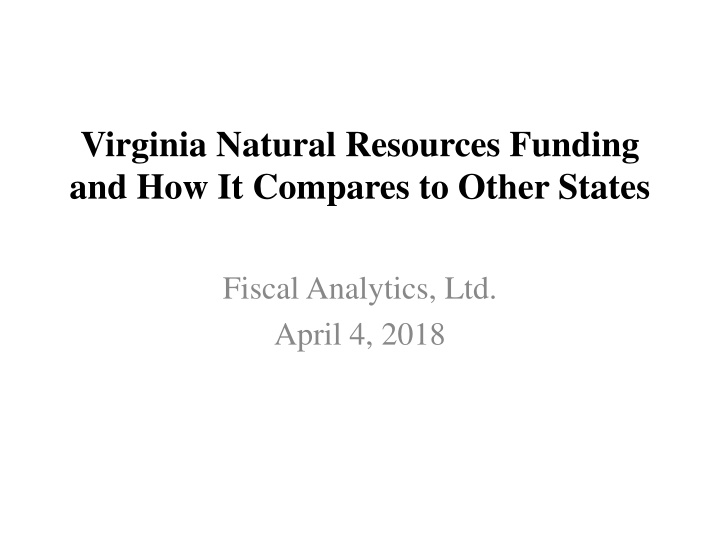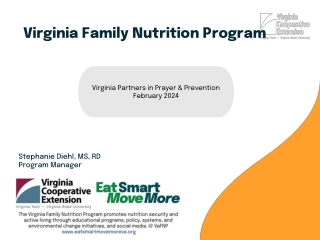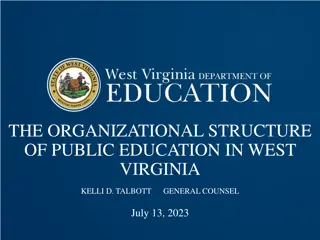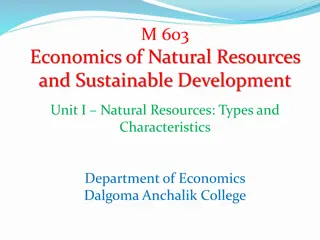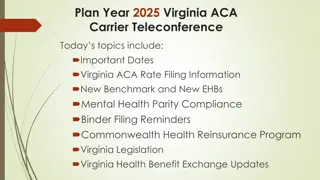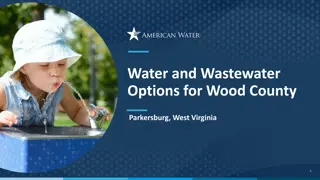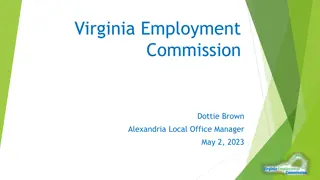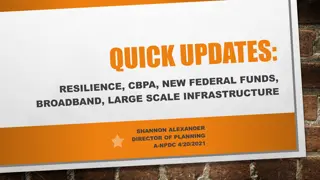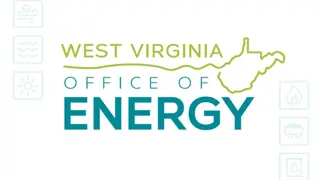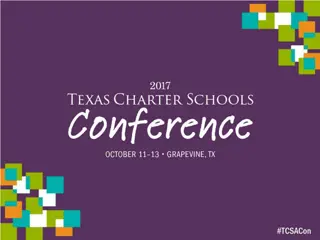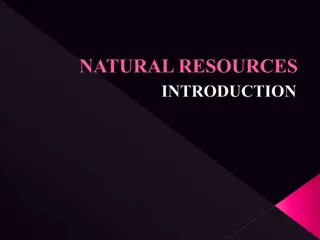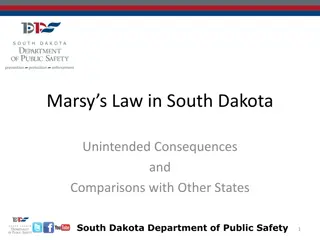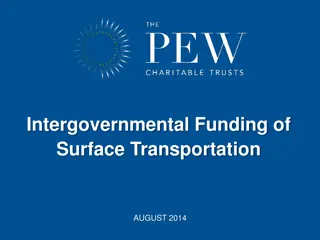Virginia Natural Resources Funding and How It Compares to Other States
This study commissioned by VirginiaForever explores trends in natural resource funding in Virginia compared to neighboring states, emphasizing funding levels for land conservation and water quality. It provides detailed data on appropriations for various agencies involved in managing Virginia's natural resources, offering insights into budget allocations and funding sources for fiscal years 2018 and 2019.
Download Presentation

Please find below an Image/Link to download the presentation.
The content on the website is provided AS IS for your information and personal use only. It may not be sold, licensed, or shared on other websites without obtaining consent from the author.If you encounter any issues during the download, it is possible that the publisher has removed the file from their server.
You are allowed to download the files provided on this website for personal or commercial use, subject to the condition that they are used lawfully. All files are the property of their respective owners.
The content on the website is provided AS IS for your information and personal use only. It may not be sold, licensed, or shared on other websites without obtaining consent from the author.
E N D
Presentation Transcript
Virginia Natural Resources Funding and How It Compares to Other States Fiscal Analytics, Ltd. April 4, 2018
Introduction Virginiaforever commissioned study of Virginia natural resource funding trends and how it compares to other states. Study looked at specific funding levels for land conservation and water quality. Particular emphasis was placed on comparisons with Chesapeake Bay neighboring states. 2
FY 2018 Virginia Natural Resource Funding FY 2018 Appropriations Natural Resource Agency General Fund Special Funds Federal Funds Total Secretary of Natural Resources $587,173 $0 $100,000 $687,173 Environmental Quality (DEQ) $39,560,090 $86,726,841 $50,431,206 $176,718,137 Conservation and Recreation (DCR) $49,922,661 $38,563,749 $11,728,919 $100,215,329 Game and Inland Fisheries (DGIF) $0 $46,555,222 $16,278,143 $62,833,365 Marine Resources Commission $12,470,957 $8,887,439 $3,430,800 $24,789,196 Historic Resources $4,431,398 $845,994 $1,565,926 $6,843,318 Museum of Natural History Total NR Secretariat Dept. of Forestry Forest Mgmnt VDACS Farmland Preservation $2,660,680 $109,632,959 $18,383,948 $250,000 $338,075 $181,917,320 $10,340,210 $95,000 $3,093,755 $375,180,273 $33,514,311 $250,000 $83,629,994 $4,790,153 $0 $0 Total State Operating Appropriations $20,455,842,859 $23,754,439,454 $8,395,868,236 $52,606,150,549 Natural Resource Capital Approp. $0 $6,291,000 $4,763,000 $11,054,000 Total State Capital Appropriations NR as a % of Total State $0 $489,813,132 $4,763,000 1.11% $494,576,132 0.63% 0.82% 0.79% 3 3
FY 2019 Virginia Natural Resource Funding FY 2019 HB 30, Introduced Appropriations Natural Resource Agency General Fund Special Funds Federal Funds Total Secretary of Natural Resources $609,254 $0 $102,699 $711,953 Environmental Quality (DEQ) $39,792,583 $89,265,945 $50,694,424 $179,752,952 Conservation and Recreation (DCR)* $74,388,003 $42,228,826 $12,932,770 $129,549,599 Game and Inland Fisheries (DGIF) $0 $49,764,189 $13,837,576 $63,601,765 Marine Resources Commission $13,152,535 $9,108,613 $3,430,800 $25,691,948 Historic Resources $4,650,230 $1,182,635 $2,095,715 $7,928,580 Museum of Natural History $2,833,105 $343,410 $95,596 $3,272,111 Total NR Secretariat $135,425,710 $191,893,618 $83,189,580 $410,508,908 Dept. of Forestry Forest Mgmnt $19,055,285 $10,624,580 $4,290,153 $33,970,018 VDACS Farmland Preservation $250,000 $0 $0 $250,000 Total State Operating Appropriations $20,871,213,958 $25,974,249,289 $9,617,160,351 $56,462,623,598 Natural Resource Capital Approp. $0 $12,000,000 $6,500,000 $18,500,000 Total State Capital Appropriations $10,000,000 $724,475,000 $11,000,000 $745,475,000 NR as a % of Total State 0.79% 0.80% 0.98% 0.81% * Includes $22.5 mil. deposit to the WQIF from FY 2017 revenue/balance surplus 4
Includes Natural Resources Secretariat operating appropriations plus Dept. of Forestry Forest Mgmt., Farmland Preservation Note: Natural resource appropriations do not include debt service payments on bonds contained within the Treasury Board budget. 5 5 5
General Fund Operating Appropriation Growth ($ Mil.) Annualized Compound Growth 2001 2018 Growth Medicaid (DMAS) $1,384.2 $4,651.7 236.1% 7.4% GF Debt Service $243.1 $739.5 204.2% 6.8% Behavioral Health $430.2 $772.6 79.6% 3.5% Other H&HS $648.9 $1,059.0 63.2% 2.9% K-12 Public Education $3,942.4 $5,972.7 51.5% 2.5% Public Safety/Comp Board $1,949.1 $2,588.3 32.8% 1.7% Higher Education $1,634.2 $2,015.2 23.3% 1.2% Natural Resources/Forest M $152.1 $128.2 -15.7% -1.0% All Other $1,899.4 $2,372.1 24.9% 1.3% Total GF Operating $12,283.6 $20,299.3 65.3% 3.0% Note: Since 2001, the Consumer Price Index has averaged 2.0%. 6 6 6
NR Capital Needs Rely on Patchwork of Different Fund Sources Bonds Have Been Periodically Authorized for Water Quality Fiscal Year 2014 General Federal Special Bonds* Credits Land Conservation Wastewater 140,432,800 5,738,800 28,694,000 Stormwater 35,000,000 Non-Point Source Total Authorization 73,796,521 1,000,000 9,100,000 258,329,321 0 0 0 0 0 0 2,000,000 0 9,100,000 0 106,000,000 35,000,000 0 0 70,796,521 0 0 2015 General Federal Special Bonds Credits 73,478,333 2,000,000 1,107,874 2,472,126 41,840,100 13,292,100 28,548,000 23,292,479 33,897,500 23,897,500 172,508,412 0 3,292,479 0 0 0 0 0 10,000,000 0 20,000,000 0 0 67,898,333 0 2016 General Federal Special Bonds Credits 78,543,846 5,927,000 110,374 2,139,626 32,812,800 5,468,800 27,344,000 8,292,479 5,000,000 3,292,479 28,881,888 10,696,471 148,531,013 0 0 0 0 0 0 0 18,185,417 0 0 0 70,366,846 2017 General Federal Special Bonds 14,526,000 8,500,000 2,123,000 3,903,000 59,000,000 23,292,479 71,708,800 61,708,800 168,527,279 0 0 3,292,479 0 0 0 10,000,000 0 59,000,000 20,000,000 0 2018 General Federal Special Bonds * Does not include $75 mil in CSO bonds authorized for Richmond and Lynchburg 12,404,000 4,750,000 2,013,000 5,641,000 0 3,292,479 18,274,474 33,970,953 0 0 0 3,292,479 0 0 18,274,474 0 0 7
VA Direct Land Conservation Funding VLCF-NGF Approps 500,000 Capitol VFPF Direct Appropriations Year 2000 2001 2002 2003 2004 2005 2006 2007 2008 2009 2010 2011 2012 2013 2014 2015 2016 2017 2018 VLCF-GF 1,250,000 9,600,000 VLCF-Total 1,750,000 9,600,000 Authorizations 4,500,000 1,000,000 50,000,000 - - - - - - - - 500,000 1,463,275 438,043 972,523 963,269 397,880 1,463,275 12,938,043 3,472,523 3,963,269 3,397,880 2,000,000 2,004,666 2,500,000 3,500,000 3,000,000 3,000,000 3,000,000 6,000,000 10,000,000 6,500,000 - 12,500,000 2,500,000 3,000,000 3,000,000 2,000,000 2,000,000 500,000 1,500,000 1,000,000 1,000,000 1,000,000 4,000,000 8,000,000 4,500,000 6,000,000 100,000 4,030,000 - 31,000,000 500,000 500,000 4,666 - - - - - 2,000,000 2,000,000 2,000,000 2,000,000 2,000,000 2,000,000 2,000,000 2,000,000 1,580,000 427,000 4,026,000 5,654,000 1,000,000 1,750,000 500,000 250,000 Note: Does not include Battlefield Preservation Fund. FY 2018-20 introduced budget maintained $4.5 m. VLCF GF appropriation. House budget eliminated FY 2019 amount, Senate budget reduced each year by $3.0 m. 8 8
Virginia Wastewater/Stormwater Funding * Wastewater Stormwater Clean Water Revolving Loan Fund -- State & Year 2000 2001 2002 2003 2004 2005 2006 2007 2008 2009 2010 2011 2012 2013 2014 2015 2016 2017 2018 DEQ/WQIF 13,870,000 13,000,000 Bonds SLAF Federal - 35,672,280 32,994,029 32,797,038 32,610,724 32,546,804 26,506,882 21,547,742 26,284,500 16,711,477 16,711,477 50,037,600 36,264,000 34,708,000 32,787,600 34,432,800 34,257,600 32,812,800 - - - 13,252,500 84,188,600 217,000,000 20,000,000 476,000 - 250,000,000 3,644,300 - 87,569,394 1,000,000 35,000,000 23,292,479 28,292,479 3,292,470 3,292,470 106,000,000 7,582,500 - 59,000,000 9 * Does not include $75 mil in CSO bonds authorized in FY 2014 for Richmond and Lynchburg. $20 mil CSO proposal for FY 2019.
Virginia Non-Point Pollution Control Funding* Year 2000 2001 2002 2003 2004 2005 2006 2007 2008 2009 2010 2011 2012 2013 2014 2015 2016 2017 2018 DCR/WQIF (GF) 9,831,250 12,040,462 1,040,462 3,652,981 Recordation Fees/Other NGF DCR/WQIF Reserve Fund 1,000,000 2,179,000 2,200,637 685,473 9,876,357 61,346,933 4,285,868 685,473 1,112,300 15,200,000 27,878,895 - - - - - - 226,616 9,111,940 199,605 500,000 20,000,000 4,800,000 4,919,805 9,100,000 9,100,000 9,100,000 9,100,000 10,000,000 10,000,000 10,000,000 10,000,000 - - 19,679,048 1,300,000 20,931,888 10,696,471 53,464,590 2,965,612 8,185,417 8,244,210 8,274,474 - * Does not include AG BMP tax credit program (approx. $1 mil per year) 10
Tax Credits for Land Conservation Are Also Available Virginia Land Preservation Tax Credit Tax Credits Allocated Tax Credits Claimed Year # of Credits # of Acres 2000-06 1,557 295,070 $736,837,981 $426,832,755 2007-08 478 119,504 $202,287,081 $236,858,621 2009 228 63,409 $106,647,006 $85,153,370 2010 146 38,551 $106,845,000 $131,579,152 2011 367 75,025 $108,424,000 $118,426,367 2012 228 45,329 $64,090,780 $95,100,354 2013 234 64,909 $78,882,596 $69,991,847 2014 136 31,428 $55,648,387 $70,796,521 2015 182 42,362 $48,625,672 $67,898,333 2016* 163 30,983 $58,475,935 $70,366,846 2017* 31 7,216 $7,865,915 Total 3,750 813,786 1,574,630,353 $1,373,004,166 * Partial year data. Tax credits are allocated and claimed on a calendar year basis rather than a fiscal year. Source: Larry Durbin, Assistant Tax Commissioner, Va Dept. of Taxation, May 24, 2017 11 11
How Does Virginia NR Funding Compare to Virginiaforever Goals? Virginiaforever s Five-Year Plan 2015-2019: $833,785,000 state investment to meet land conservation goals. $805,000,000 state investment to meet water quality, wastewater, stormwater, and agriculture BMP improvement goals. Current State FY 2015-2019 Funding Policies: $410 million appropriated/tax credits for land conservation (mainly Land Preservation Tax Credits). House budget cuts VLCF GF budget by $4.5 mil. in FY 2019, Senate budget cuts VLCF $3 mil. each year. - Assumes $75 million in each fiscal year 2017-19 for the land preservation tax credit. - Virginiaforever s Five-Year Plan for land conservation underfunded by at least $423 million. $545 million appropriated for water quality and agriculture BMP. - Assumes $106 million in wastewater bonds, $75 million in combined sewer overflow bonds for Richmond and Lynchburg cities, and the $35 million for the Stormwater Local Assistance Fund (SLAF) authorized in the 2014 Session, plus $20 mil. for CSO bonds (FY 19) are included as issued in 2015-19. - Assumes current trends in the state match for the Clean Water Revolving Fund and $10 million in recordation fees allocated for agriculture BMP s in FY 2019. Also includes the recently announced $22.5 million in Part A and B FY 2019 deposits to the Water Quality Improvement Fund (WQIF) as a result of the FY 2017 revenue and balance surplus and $1 mil. per year in Ag BMP tax credits. - Virginiaforever s Five-Year Plan for water quality underfunded by $260 million. 12
U.S. Census Bureau Data Ranks Virginia Near the Bottom in Natural Resource Spending 13
U.S. Census Bureau Data Ranks Virginia Much Lower than our Surrounding States Percent of State General Revenue Spent Directly on Natural Resources US Average MD NC PA VA 2015 2014 2013 2012 2011 2010 2009 2008 2007 2006 1.21% 1.80% 1.26% 1.35% 1.33% 1.37% 1.51% 1.49% 1.52% 1.44% 1.39% 1.31% 1.29% 1.52% 1.42% 1.57% 2.18% 1.95% 1.89% 1.55% 1.02% 1.03% 1.07% 1.31% 1.36% 1.26% 1.85% 1.61% 1.61% 1.33% 0.89% 0.92% 0.92% 1.31% 0.95% 1.08% 1.08% 1.12% 1.08% 1.04% 0.60% 0.61% 0.61% 1.74% 1.75% 0.64% 0.65% 0.59% 0.60% 0.64% 14
According to ECOS*, Virginia Ranks in the Middle for Environmental Regulatory Agency Spending * Environmental Council of the States 15
VA Environmental Regulatory Spending is Less than Other Chesapeake Bay States Per Capita EAB Spending FY 2014 Per Capita EAB Spending FY 2013 FY 2015 EAB Budget Per Capita EAB Spending FY 2015 Population Virginia 8,383,993 $282,201,486 $33.66 $26.55 $28.43 Pennsylvania 12,802,503 $649,584,000 $50.74 $51.67 $46.91 Maryland 6,006,401 $379,064,123 $63.11 $62.42 $78.29 16
Maryland is the Leader in Spending for Chesapeake Bay Restoration State Spending for Chesapeake Bay Watershed Restoration ($ Thous.) FY 2015 FY 2016 FY 2017 FY 2018 Delaware $750 $750 $750 $750 District of Columbia $39,628 $49,631 $63,271 $45,025 Maryland $498,519 $739,882 $488,377 $748,382 New York $6,723 $9,522 $7,312 $8,690 Pennsylvania $86,529 $51,080 $88,620 $37,015 Virginia $226,175 $227,717 $228,131 $204,725 West Virginia $43,326 $86,083 $35,733 $9,367 TOTAL $901,650 $1,164,665 $912,194 $1,053,954 Source: http://chesapeakeprogress.com/files/CBARA_Reporting_FY18_Chesapeake_Bay_Crosscut_FINAL.pdf 17
Virginia Chesapeake Bay Restoration Spending* FY 2015 FY 2016 FY 2017 FY 2018 Department of Conservation and Recreation Soil and Water Conservation Ag Best Management Practices Assistance State Park Management and Operations Preservation of Open Space and Natural Heritage General Administration and Other Subtotal DCR $7,595 $14,879 $22,962 $4,735 $8,129 $58,300 $8,184 $14,503 $24,770 $5,840 $7,550 $60,847 $9,406 $24,180 $25,776 $7,185 $9,813 $76,360 $7,655 $5,280 $24,404 $7,714 $8,000 $53,053 Department of Environmental Quality Water Quality Improvement Point Source Water Quality Improvement Non-Point Source Clean Water SRF Stormwater Local Assistance and Management Water Quality Management Richmond and Lynchburg Cities CSO Land Management Petroleum Remediation Air Quality Superfund, Litter Control and Recycling Subtotal DEQ $65,143 $306 $34,972 $11,375 $14,335 $3,585 $4,936 $21,636 $8,594 $2,993 $167,875 $53,149 $259 $45,734 $6,132 $14,374 $7,980 $4,491 $23,138 $8,583 $3,030 $166,870 $42,849 $181 $34,344 $16,450 $15,041 $3,261 $4,876 $23,808 $7,961 $3,000 $151,771 $21,316 $900 $34,000 $21,497 $16,211 $17,000 $4,568 $24,253 $8,837 $3,090 $151,672 Total Virginia State Programs $226,175 $227,717 $228,131 $204,725 * FY 2018 report provided to Congress in response to Section 3 of the Chesapeake Bay Accountability and Recovery Act (CBARA). 18
Maryland Chesapeake Bay Restoration Spending ($ Mil.) (Not Including Transportation and Higher Ed. Research) 2014 (a) 2015 (a) 2016 (a) 2017 2018 (approp.) (allowance) Spending Category Land Preservation Septic Systems Wastewater Treatment Urban Stormwater Agriculture BMP's Oyster Restoration Living Resources Other $77.3 $29.2 $262.5 $81.3 $42.0 $15.2 $43.9 $11.6 $54.8 $21.4 $249.9 $33.2 $46.9 $11.9 $66.3 $13.7 $59.9 $25.9 $512.3 $9.6 $62.1 $11.1 $41.3 $14.0 $61.1 $21.1 $244.5 $12.3 $64.8 $8.3 $58.8 $13.8 $91.0 $21.6 $479.2 $12.1 $60.0 $7.6 $57.8 $15.3 Total $563.0 $498.1 $736.2 $484.7 $744.6 19
Maryland NR Financing Maryland has been a leader in enactment of strategies to reach its goals of cleaning up the Chesapeake Bay. Funding for Chesapeake Bay restoration has averaged $600 million per year from FY 2014 through FY 2018. Program Open Space (1970), Agricultural Land Preservation Fund (1977), Rural Legacy Program (1997), and Heritage Conservation Fund - Funded with 0.5% real estate transfer tax that generates about $200 mil. per year. (Revenues have often been diverted to the state GF.) Water Quality Revolving Loan Fund - Allows local governments to access lower cost capital in lieu of issuing local debt. The Bay Restoration Fund (2004) - Each residential dwelling that receives an individual sewer bill and each onsite sewage disposal system or holding tank that receives a water bill is subject to a $5.00 monthly fee ($100 mil. per year). - Each user of an onsite sewage disposal system that does not receive a water bill and each user of sewage holding tank that does not receive a water bill is subject to a $60 annual fee ($27 mil. per year). Chesapeake and Atlantic Coastal Bays Trust Fund (2007) - Funds non-point source nutrient and sediment reduction projects and is capitalized with about $50 million in revenue from Maryland motor fuel and car rental taxes. 20
Pennsylvania NR Financing Despite the following dedicated revenues for natural resources, Pennsylvania faces serious challenges in meeting its commitments to reduce TMDL s into the Chesapeake Bay. The Keystone Recreation, Park and Conservation Fund (1993) - Dedicates 0.15% real estate transfer tax to recreation, parks, and land conservation. Requires a minimum 50% match from recipient municipality or nonprofit organizations. Agricultural Conservation Easement Fund - About 17 cents of the state cigarette tax of $2.60 per pack ($20.5 mil./year) to help preserve farmland. Recycling and Environmental Stewardship Fund - $2.00 per ton fee (1989) and $0.25 per ton (1999) to grants to municipalities for recycling programs, waste facility studies, and state programs concerning litter control, recycling and waste reduction. - $35 mil. from the Oil and Gas Lease Fund Growing Greener Initiative (1999 and 2005) - Dedicated bond funding - $4.00 per ton tipping fee (2002) at municipal landfills to finance land conservation and other environmental programs ($60 mil/year). 21
North Carolina NR Financing In 2010, NC eliminated its dedicated source of NR funding and combined the Natural Heritage Trust Fund with the Clean Water Management Trust Fund. - Formerly had dedicated funding for land conservation through a 10 cent per $100 real estate transfer tax. Since the repeal of its dedicated funding source and tax credits, NC has relied upon General Fund appropriations, both recurring and one-time to support the three remaining conservation trust funds. 1) the Parks and Recreation Trust Fund, 2) the Clean Water Management Trust Fund, and 3) the Agriculture Development and Farmland Preservation Trust Fund. In 2015, the NC General Assembly also repealed their conservation tax credit. - The credit was for 25 percent of the fair market value of property donated for conservation purposes not to exceed $500K for corporations and $250k for individuals. Unlike Virginia, the credits could not be sold. 22
Examples of State Dedicated Revenue Sources for Natural Resources Real estate transfer taxes, deed recording fees Dedicated sales taxes Dedicated lottery revenues Dedicated cigarette taxes* Waste disposal tipping fee Royalties on sale and lease of mineral rights Dedicated motor fuel and car rental taxes Water utility and flush fees * Avg. state cigarette tax is $1.72 /pack. Va ranks 50th at 30 cents. Georgia is 49th at 37 cents. 7 cent increase in VA tax would generate about $33 mil. per year. 23
Virginia Has the Most Generous Land Preservation Tax Credit State Credit Max/Taxpayer (Cap) Yrs Carryfwd Transferable? Cost/yr? Arkansas 50% of FMV $5,000/year ($500,000) 9 No Wildlife Conservation Board must approve the conservation values. Minimal California 55% of FMV None 8 No Colorado 50% of FMV $375,000 ($22,000,000) 20 Yes $15.2 mil. in 2011 Connecticut 50% of FMV None 25 No less than $1 mil. per year Delaware 40% of FMV $50,000 - $1,000,000 5 No Max. $30 mil. No new credits after 12/31/2016 $250,000 individuals / $500,000 Corp. Georgia 25% of FMV 10 Yes Iowa 50% of FMV $100,000 20 No Maryland 100% of FMV $80,000 capped $5,000/yr 15 No less than $1 mil. per year Massachusetts 50% of FMV $50,000 - $2,000,000 refundable No 50% of transaction cost from easement creation Mississippi $10,000 10 No $8.39 mil. from 2011-2015; 64,146 acres preserved; stringent approvals needed New Mexico 50% of FMV $250,000 20 Yes 25% of property tax on property under easement New York $5,000 Annual Benefit No $250,000 individuals / $500,000 Corp. Repealed 2015 N. Carolina 25% of FMV 5 No Max 25% of FMV or $250/acre S. Carolina $52,500/yr As Necessary Yes $12 mil./yr avg since 2010 Virginia 40% of FMV $50,000/yr - $75,000,000 13 Yes See Table 24
FY 2018 GF Revenue Growth Encouraging Versus Forecast, Likely Year-End Surplus Resulting in a WQIF Allocation Thru Feb. GF Growth % of GF Est. Growth Withholding 63.1% 3.5% 5.6% Est Payments/Tax Dues 4.3% 19.0% 16.8% Refunds -10.1% 5.8% 7.9% Net Individual Income 69.8% 3.4% 7.5% Sales Taxes* 18.0% 3.0% 3.2% Corporate Income 4.4% 5.7% 13.3% Recordation 2.1% 3.3% -2.3% Insurance Premiums 1.9% 6.2% -25.6% Total GF Revenues 3.4% 6.2% 100.0% * 19.2% share of GF when including 0.375 cent sales tax transfer to the GF 25 25
GF Spending Programs and Policies Are Not Sustainable at 6% Medicaid Growth and 3-4% Revenue Growth 50.0% 45.0% All Other (Net Debt Service) 40.0% 35.0% K-12 Direct Aid @ 3% growth % of General Fund 30.0% 25.0% Medicaid @ 6% growth 20.0% 15.0% 10.0% 5.0% 0.0% 2017 2018 2019 2020 2021 2022 2023 2024 2025 2026 26 26 26
But Virginia Has Relatively Little Room for More Borrowing* Introduced Budget Proposed Authorizing $730 Mil. in New Debt in FY 20 Virginia Debt per Capita Compared to Other States $1,600 $1,400 $1,200 $1,000 $800 $600 $400 $200 $0 2007 2008 2009 2010 2011 2012 2013 2014 2015 2016 2017 Virginia Median State AAA-Rated Median * Additional debt capacity based on self-imposed cap of 5% of GF + transportation revenues. DCAC model assumes an average of $580 mil. per year over next 10 years can be issued. Source: Virginia Debt Capacity Advisory Board, Dec. 2017 27 27 27 27
National Rankings Indicate a Relatively Low State Tax Burden Given our State s Wealth 2012 JLARC Ranking 2018 JLARC Ranking Per capita personal income 8 12 Per capita state taxes 34 33 Per capita local taxes 13 16 Source: Virginia Compared to Other States, JLARC, 2012, 2018 Editions 28 28 28 28 28 28
Summary Low growth in state GF revenues and high growth in Medicaid and debt service has meant a continued degradation in ongoing GF state support for natural resource programs. Will Medicaid expenditure growth slow by moving to managed care, and will revenues sustain faster growth to allow more state investment in natural resources? - Since the 2009 recession, state funding has not been restored to many priority programs, including education. - There is very limited new state debt capacity available and still remain a AAA-rated state. Governor and General Assembly have created another reserve fund to maintain AAA rating causing additional scarcity for restoring funding. Local revenues are under even more stress than state revenue sources. A sustainable new revenue source is needed if Virginia is to meet goals for land conservation and water quality. 29 29 29 29
Appendix 30
Governors Introduced Budget GF Budget Accounting ($ Mil.) Change from FY18 $ $4.3 $10.4 $22.4 $19.6 $160.1 - $0.0 $5.4 $28.2 $266.3 $104.6 -$0.5 $102.4 $92.8 $2.0 -$139.8 -$106.4 $10.1 $581.9 $768.3 -$7.0 Change from FY19 $ $0.0 $0.0 $2.9 $48.5 -$1.4 - $0.0 $1.4 -$23.0 $103.3 $28.8 $145.1 $79.6 $11.0 $0.0 $117.1 $170.7 -$5.1 $678.9 $795.8 $10.1 2018 Caboose FY 2019 $123.7 496.0 736.7 759.1 191.2 % FY 2020 $123.7 496.0 739.6 807.6 189.8 % Legislative and Executive Judicial Dept. Administration/Comp Board Treasury Board Debt Service Other Finance/Technology Rainy Day Fund Deposit Car Tax Reimbursement Commerce and Trade Nat. Resources/Agriculture K-12 Education/Central Office Higher & Other Education DMAS Medicaid Other Health & Human Services Public Safety & Veterans/HS Transportation Central Appropriations Cash Reserve Independent Agencies/Capital Total GF Appropriations GF Revenues Transfers Rainy Day Fund Withdrawal Balances for Appropriation Unappropriated Balance $119.4 485.6 714.3 739.5 31.1 3.6% 2.1% 3.1% 2.7% 514.8% 0.0% 0.0% 0.4% 6.4% -0.7% - - - - - 950.0 203.5 163.7 6,031.2 2,015.2 4,651.7 1,847.1 1,938.0 41.0 211.3 156.4 950.0 208.9 191.9 6,297.5 2,119.8 4,651.2 1,949.5 2,030.8 43.0 71.5 50.0 10.4 $20,881.2 20,096.5 615.7 0.0% 2.7% 17.2% 4.4% 5.2% 0.0% 5.5% 4.8% 4.9% -66.2% -68.0% NM 2.9% 4.0% -1.1% 950.0 210.3 168.9 6,400.8 2,148.6 4,796.3 2,029.1 2,041.8 43.0 188.6 220.7 0.0% 0.7% -12.0% 1.6% 1.4% 3.1% 4.1% 0.5% 0.0% 163.8% 341.4% -49.0% 3.3% 4.0% 1.6% 0.3 5.3 $20,299.3 19,328.2 622.7 272.5 201.6 $21,560.1 20,892.3 625.8 - - 22.0 54.6 (0.5) 12.1 31 31 31 31
